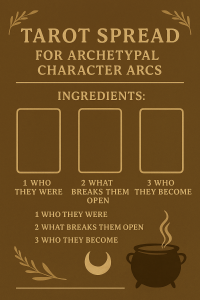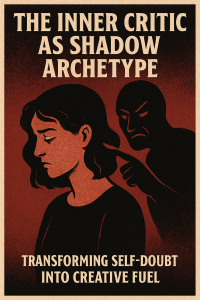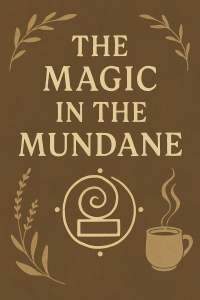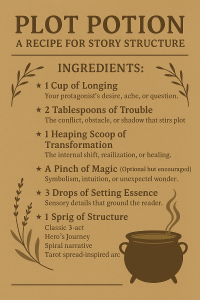Ellie Potts's Blog, page 4
August 18, 2025
Plot Twists & Character Arcs: How to Use Tarot to Deepen Your Story

Tarot isn’t just for divination—it’s a storytelling tool.
Each card holds archetypes, emotions, and turning points that mirror the journeys we write.
Whether you’re stuck in the middle of your draft or craving a twist that feels earned, tarot can help you listen to your story’s soul.
 Why Tarot Works for Writers
Why Tarot Works for WritersTarot is built on narrative.
The Fool’s Journey is a classic character arc.
The cards reflect transformation, tension, and revelation—everything a good story needs.
Using tarot invites intuition into your writing process.
It helps you move beyond logic and into emotional truth.
 How to Use Tarot for Plot Twists1. Draw a Card When You’re Stuck
How to Use Tarot for Plot Twists1. Draw a Card When You’re StuckAsk: What energy wants to enter the story now?
Examples:
Let the card guide the tone of the twist—not just the event.
2. Use Cards to Reveal Hidden MotivesAsk: What is this character hiding?
Draw a card and interpret it as their secret, fear, or shadow.
Example:
Seven of Swords → Deception, escape, or strategic silenceFive of Cups → Grief, regret, or emotional avoidanceThis deepens character arcs and adds emotional complexity.
3. Map the Arc with a SpreadTry a 3-card spread:
Card 1: Who they wereCard 2: What breaks them openCard 3: Who they becomeOr use a Celtic Cross to explore the full arc of your protagonist.
 How to Use Tarot for Character Development
How to Use Tarot for Character Development Archetype Alignment
Archetype AlignmentChoose a card that represents your character’s essence.
Examples:
Use this card to shape their voice, choices, and growth.
 Shadow Work for Characters
Shadow Work for CharactersAsk: What does this character fear? What must they release?
Draw a card and write a scene where they confront that energy.
 A Ritual to Try
A Ritual to TryBefore writing, light a candle and shuffle your deck.
Ask: What energy wants to guide this chapter?
Draw a card and place it on your writing altar.
Let it whisper to you as you write.
 Final Thought
Final ThoughtTarot doesn’t give you answers—it gives you questions.
It invites you to listen, to feel, to trust the twist.
Because every story is a journey.
And every card is a mirror.
August 17, 2025
The Inner Critic as Shadow Archetype: Transforming Self-Doubt into Creative Fuel

There’s a voice that lives in the margins of your mind.
It whispers when you start a new project.
It tightens your chest when you share your truth.
It says: “Who do you think you are?”
This is the Inner Critic.
Not a villain.
Not a mistake.
But a shadow archetype—one that holds both fear and wisdom.
And when we meet it with compassion, it becomes fuel.
 What Is the Inner Critic?
What Is the Inner Critic?The Inner Critic is the part of you shaped by shame, perfectionism, and fear of rejection.
It often echoes old voices—teachers, parents, systems—that taught you to shrink.
But beneath its harshness is a desire to protect you.
To keep you safe.
To avoid vulnerability.
It’s not here to destroy your creativity.
It’s here to test your devotion to it.
 The Inner Critic as Archetype
The Inner Critic as ArchetypeIn shadow work, we treat the Inner Critic as an archetype—a symbolic figure with a role, a voice, and a story.
You might imagine yours as:
A stern librarian guarding the gates of your imaginationA masked judge who fears your truthA wounded child who learned that being visible was dangerousNaming the archetype helps you dialogue with it.
It gives you distance.
It lets you ask: What do you need? What are you afraid of? What are you trying to protect?
 Writing Prompts to Transform Self-Doubt
Writing Prompts to Transform Self-DoubtUse these prompts to meet your Inner Critic and reclaim your voice:
“My Inner Critic sounds like…”“It tries to protect me from…”“What I want to say back is…”“If I believed in my voice, I would create…”“The story my Inner Critic is afraid I’ll tell is…”Let the answers be messy. Let them be honest. Let them be yours.
 A Ritual for Reclaiming Your Voice
A Ritual for Reclaiming Your VoiceTry this when self-doubt feels loud:
You’ll need:
A candleA journal or sketchbookOptional: tarot deck, cannabis, grounding stoneSteps:
Light your candle and say: “I honor my shadow. I reclaim my voice.”Pull a tarot card to represent your Inner Critic.Write a letter to it. Let it speak. Then respond.Create a sigil or symbol for your creative truth.Place it on your altar. Let it remind you: You are allowed to create. Closing Reflection
Closing ReflectionThe Inner Critic isn’t your enemy.
It’s your shadow teacher.
It asks: Will you choose fear—or truth?
Silence—or story?
When you meet it with compassion, you don’t just quiet the voice.
You transform it.
You turn self-doubt into depth.
You turn resistance into ritual.
You turn fear into fuel.
August 16, 2025
Change
What positive emotion do you feel most often?
When change is brought up it causes fear and anxiety. But I’m pretty good with accepting change. Because it’s a daily occurrence. You can’t move forward without change. Change is all around us. So I happily accept change daily with positivity and an open heart.
The Magic in the Mundane: How Everyday Rituals Become Sacred Acts

There’s a kind of hush that falls over the kitchen at 7:43 a.m.—
the clink of a spoon against ceramic, the steam rising from a chipped mug, the soft creak of floorboards under bare feet.
It’s not dramatic.
It’s not Instagram-worthy.
But it’s magic.
We’re taught to chase the extraordinary.
To believe that magic lives in mountaintops, moonlit ceremonies, or perfectly curated altars.
But what if it’s also in the laundry?
In the way you fold your favorite shirt with care?
In the way you whisper “thank you” to your body as you stretch?
 The Myth of “Big Magic”
The Myth of “Big Magic”For those of us who live with sensitivity—whether it’s misophonia, neurodivergence, or the quiet ache of perimenopause—life doesn’t always allow for grand rituals.
Sometimes, magic is survival.
Sometimes, it’s remembering to drink water.
Sometimes, it’s lighting a candle not to summon spirits, but to soften the edges of a hard day.
We don’t need to perform magic.
We just need to notice it.
 Micro-Rituals as Portals
Micro-Rituals as PortalsHere are a few ways I’ve found magic in the mundane:
Stirring intention into my morning coffee: “May this nourish my creativity.”Brushing my hair while whispering affirmations: “I am here. I am whole.”Creating a sigil with my breath on a foggy mirror.Folding laundry while imagining each piece as a layer of protection.These small acts become spells.
They anchor me.
They remind me that I am allowed to move slowly, to feel deeply, to honor my rhythms.
 Advocacy Through Attention
Advocacy Through AttentionFor many of us—especially women navigating hormonal shifts or neurodivergent cycles—being seen is rare.
But when we treat our daily rituals as sacred, we reclaim that visibility.
We say: My life matters. My care matters. My softness is not a flaw—it’s a form of magic.
 A Creative Invitation
A Creative InvitationToday, choose one mundane task.
Approach it as if it were sacred.
Light a candle before you do it.
Speak a mantra.
Notice the textures, the sounds, the emotions.
Then ask yourself:
What shifted? What did I reclaim? What did I remember?
 Closing Thought
Closing ThoughtMagic doesn’t always roar.
Sometimes, it hums in the laundry, glimmers in the dishwater, and waits patiently in the quiet corners of your day.
You don’t have to chase it.
You just have to listen.
August 15, 2025
With the hopes I will get to them.
How do you plan your goals?
My goals get tangled sometimes. I try to complete them. And some I do, while others I just can’t keep up with. I buy a physical yearly planner every year in hopes it will keep me on track but I still find myself lacking. I look forward to reading how everyone else plans so maybe I can take notes. Happy Friday blogger friends! I hope your weekend goals are met 
🧪 Plot Potion: A Recipe for Story Structure That Feeds Your Muse

Welcome to your story cauldron.
Here, structure isn’t a cage—it’s a spell.
A recipe.
A rhythm.
Something you stir with intention, intuition, and a dash of rebellion.
Whether you’re writing a blog post, a memoir, or a fantasy epic, this potion helps you shape your story without losing its soul.
 Plot Potion Recipe
Plot Potion Recipe Ingredients:1 Cup of Longing
Ingredients:1 Cup of LongingYour protagonist’s desire, ache, or question.
(What do they want? What’s missing?)2 Tablespoons of Trouble
The conflict, obstacle, or shadow that stirs the plot.
(What gets in the way? What must be faced?)1 Heaping Scoop of Transformation
The internal shift, realization, or healing.
(How do they change? What do they learn?)A Pinch of Magic (Optional but encouraged)
Symbolism, intuition, or unexpected wonder.
(What makes this story uniquely yours?)3 Drops of Setting Essence
Sensory details that ground the reader.
(Where are we? What does it smell, sound, or feel like?)1 Sprig of Structure
Choose your base:Classic 3-actHero’s JourneySpiral narrativeTarot spread-inspired arc
 Instructions:Begin with Longing.
Instructions:Begin with Longing.Place it at the center of your cauldron. Let it simmer.
This is your story’s heartbeat.Add Trouble slowly.
Stir clockwise. Let tension rise.
Don’t rush—let the conflict unfold in layers.Sprinkle in Setting Essence.
Add sensory details as needed.
Taste, texture, temperature—make it immersive.Fold in Transformation.
This ingredient is subtle.
It may not appear until the end, but it must be present.Optional: Add Magic.
A symbol, a sigil, a dream sequence, a moment of awe.
This is your secret spice.Finish with Structure.
Pour your story into a vessel that fits.
Don’t worry if it spills over—this potion is alive.
 Serving Suggestions:Pair with a candle-lit writing altar and a playlist that evokes your story’s mood.Use tarot cards to guide your plot beats.Write your story in scenes, then rearrange like ingredients in a stew.
Serving Suggestions:Pair with a candle-lit writing altar and a playlist that evokes your story’s mood.Use tarot cards to guide your plot beats.Write your story in scenes, then rearrange like ingredients in a stew. Final Note
Final NotePlot doesn’t have to be linear.
It can spiral, shimmer, or unfold like a ritual.
This potion is yours to adapt.
Just remember: every story begins with longing—and ends with transformation.
August 14, 2025
Emergency…
Create an emergency preparedness plan.
Growing up in California we have emergency prep drilled into us from such a young age. Earthquake get under your desk! Fire, stop, drop and roll. Know your exits. Know the safest place to stand away from medical or emergency people. What they can’t teach you is how you will react in situations. Not everyone is going to have a cool head when alarms and screaming start. I can say when it comes to emergencies I am pretty level headed. I’ve had to contact emergency services a few times and each time was praised with how I wasn’t freaked out and had stuff ready for first responders.
I will say if you can make sure you have some water stashed away. You should have an emergency kit, technically 2. One in your home, and one in your car. Have important docs in a fireproof container. Know your exits. Check your fire alarms and carbon monoxide detectors. Have plans for pets if you can. And remember don’t panic. Panic can do more damage. So take a second, breathe, and then take action.
Creating a Writing Altar

Creating a writing altar is a beautiful way to turn your creative practice into ritual—especially for shadow work, intuitive journaling, or storytelling that comes from deep within. It doesn’t have to be elaborate. It just needs to feel sacred, intentional, and uniquely you. Here’s how to begin:
 How to Create a Writing Altar1. Choose Your SpaceFind a quiet corner, desk, or surface where you feel safe and inspired.It can be permanent or something you set up just for writing sessions.Think of it as a threshold—a place where your inner world meets the page.2. Cleanse and Claim ItLight incense, burn herbs (like mugwort or lavender), or use sound (a bell or chime) to clear the energy.Say a simple intention aloud:
How to Create a Writing Altar1. Choose Your SpaceFind a quiet corner, desk, or surface where you feel safe and inspired.It can be permanent or something you set up just for writing sessions.Think of it as a threshold—a place where your inner world meets the page.2. Cleanse and Claim ItLight incense, burn herbs (like mugwort or lavender), or use sound (a bell or chime) to clear the energy.Say a simple intention aloud:“This is a space for truth, creativity, and compassion.”3. Gather Your Sacred Tools
Include items that support your writing and your spirit:
ElementExamples Writing ToolsJournal, pens, typewriter, laptop
Writing ToolsJournal, pens, typewriter, laptop Intuitive AidsTarot deck, oracle cards, runes
Intuitive AidsTarot deck, oracle cards, runes Sensory AnchorsCandle, essential oils, herbs, tea
Sensory AnchorsCandle, essential oils, herbs, tea Magical ObjectsCrystals, sigils, feathers, moon water
Magical ObjectsCrystals, sigils, feathers, moon water Symbols of InspirationPhotos, quotes, archetype cards, art
Symbols of InspirationPhotos, quotes, archetype cards, artChoose objects that evoke emotion, memory, or magic. Let them speak to your shadow and your muse.
4. Create a CenterpiecePlace one object at the center of your altar to represent your current intention.For shadow work, this could be:A black candle for depth and transformationA stone like obsidian or smoky quartzA tarot card like The Moon, The Hermit, or The Devil5. Add a Ritual ElementBefore writing, light a candle, pull a card, or say a mantra like:“I write to remember. I write to reclaim. I write to become.”You can also use cannabis ritual here—choose a strain that supports introspection and creativity, and consume with intention.
 Optional: Shadow Work EnhancementsKeep a small bowl for “emotional offerings”—notes, sketches, or words you want to release.Create a sigil for your writing altar and place it under your journal.Use moon phases to guide your writing themes (e.g., waning moon for release, new moon for intention).
Optional: Shadow Work EnhancementsKeep a small bowl for “emotional offerings”—notes, sketches, or words you want to release.Create a sigil for your writing altar and place it under your journal.Use moon phases to guide your writing themes (e.g., waning moon for release, new moon for intention). Final Thought
Final ThoughtYour writing altar isn’t just a space.
It’s a spell.
A sanctuary.
A mirror.
It holds your truth, your tenderness, your transformation.
And every time you return to it, you remind yourself:
Your words are sacred. Your shadow is welcome. Your voice is whole.
August 13, 2025
Shadow Pages: Writing Through the Dark to Find the Light

There are pages we write in the quiet.
Not for applause.
Not for clarity.
But to meet the parts of ourselves we’ve hidden.
These are Shadow Pages—a writing practice that invites you to explore, express, and integrate the aspects of self that live in the dark.
Not darkness as danger.
Darkness as depth.
As mystery.
As the fertile soil where truth begins to grow.
 What Are Shadow Pages?
What Are Shadow Pages?Shadow Pages are a ritual writing practice designed to help you:
Explore emotions you’ve avoided (shame, envy, grief, fear)Dialogue with shadow archetypes (The Wounded Child, The Saboteur, The Witch, The Outcast)Reflect on patterns, stories, and creative blocksIntegrate shadow aspects into your art, your rituals, your voiceThey’re not about fixing.
They’re about witnessing.
They’re about writing your way into wholeness.
 Writing Prompts to Begin
Writing Prompts to BeginStart with one page a day. No editing. No censoring. Just presence.
“A part of me I’ve been afraid to show is…”“If my envy could speak, it would say…”“Grief shaped my creativity by…”“My inner saboteur tries to protect me by…”“The story I’ve never told is…”Let the ink be messy. Let the truth be strange. Let the page hold it all.
 Shadow Archetypes to Explore
Shadow Archetypes to ExploreUse tarot, oracle cards, or intuitive journaling to meet these shadow aspects:
The Wounded Child: What early story shaped your fear of being seen?The Saboteur: What part of you resists success or visibility?The Witch: What power have you been taught to fear or suppress?The Outcast: Where do you feel too different, too sensitive, too much?You can write letters to these archetypes.
Draw them.
Create sigils or altar spaces to honor them.
Ask: What do you need from me? What wisdom do you hold?
 Reflection Ritual: Integrating the Shadow
Reflection Ritual: Integrating the ShadowAfter a week of Shadow Pages, try this integration ritual:
Review your pages: Highlight phrases or themes that feel potent.Create a collage or visual map: Use symbols, colors, or images to represent what you’ve uncovered.Write a closing reflection: “What have I learned from my shadow?”Create a sigil or mantra: Something like “I create from wholeness.”Place it on your altar: Let it be a reminder that your shadow is not your enemy—it’s your guide. Closing Thought
Closing ThoughtShadow Pages are not just a writing practice.
They’re a ritual of return.
A way to reclaim the stories you’ve buried.
A way to turn discomfort into depth.
A way to write your way back to the light.
Because the truth is:
You were never broken.
You were just layered.
And every page brings you closer to your whole, radiant self.
August 12, 2025
The Hidden Muse: Emotions We Avoid, Stories We Need

There’s a muse that doesn’t wear flowing robes or whisper sweet inspiration.
She doesn’t arrive with clarity or confidence.
She shows up trembling. Raw. Uninvited.
She is shame.
She is envy.
She is grief.
And she is sacred.
 The Emotions We Avoid
The Emotions We AvoidWe’re taught to fear these feelings.
To hide them.
To label them as “negative” or “unproductive.”
But in truth, they are portals—each one holding a story, a truth, a creative thread waiting to be woven.
These emotions aren’t blocks.
They’re bridges.
 Writing Prompts to Meet the Hidden Muse
Writing Prompts to Meet the Hidden MuseLet these prompts guide you into deeper creative territory. You can journal, sketch, or even use them in ritual:
Shame Speaks: “If I weren’t afraid of being judged, I would create…”Envy as Compass: “I feel envy when I see… because I secretly want…”Grief’s Gift: “Something I’ve lost that shaped how I create is…”Let the answers come unfiltered.
Let them be messy.
This is not performance—it’s permission.
 Visual Exercise: Drawing the Hidden Muse
Visual Exercise: Drawing the Hidden MuseTry this intuitive art ritual:
Close your eyes and imagine your hidden muse. What does she look like?What color is her energy? What shape does her presence take?Draw her without trying to make it “good.” Let her be abstract, strange, beautiful.Then ask:
What does she want me to create?
 Turning Discomfort into Depth
Turning Discomfort into DepthWhen you create from discomfort, you don’t just make something edgy.
You make something true.
You give voice to what others are afraid to say.
You offer resonance.
You become a mirror.
Shadow work doesn’t just heal.
It connects.
 Closing Reflection
Closing ReflectionThe hidden muse isn’t here to hurt you.
She’s here to guide you.
To show you the stories you’ve buried.
To help you turn pain into poetry, longing into ritual, silence into song.
When you meet her with compassion, she becomes your most honest collaborator.



